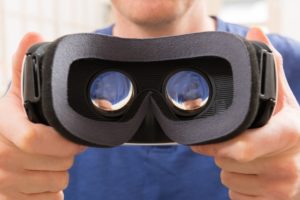Considering Sony Playstation’s VR headset sold out in pre-order last week, most of us are aware that virtual reality (VR) technology is hot right now. But outside of just hearing about the hype, what is education actually doing with this technology—if anything?
A new survey from Extreme Networks aimed to answer this question by polling nearly 350 schools within higher ed and K-12. According to the results, 23 percent of respondents have tested VR, while 77 percent have not (40 percent of schools polled still aren’t sure if they’ll use the technology in the future). Meaning that although virtual reality has an important and growing role in education, it may take several years to get all institutions on board.
The survey notes that one challenge to implementation is that nearly two-thirds of schools are “somewhat or not sure” their IT infrastructure can currently support VR technology.
Respondents also had concerns about the lack of VR content available, as well as a lack of student resources, with 43 percent of respondents saying that VR is too expensive or difficult to implement. However, one respondent is taking this approach to providing VR to students at low or no cost: “We are putting out a call for old smartphone donations in our [community for those] who no longer need them. With the donations, we’re making sets of Google Cardboard and phones to create traveling VR stations for classes in all of our buildings.”
Yet, even though current use is still at a small percentage, over half the schools surveyed report that they are actively investigating VR for classroom use, with 23 percent of schools reporting that they have tested or tried VR.
And for those pioneering educators and researchers, the uses for VR may be more diverse than the general public may think.
Next page: 5 ways virtual reality is being used in education right now
Interestingly, virtual reality is not just being used in science, as 29 percent of respondents have tried VR in history.
According to news reports and the Extreme Networks survey, here’s how VR is currently being used in schools, colleges and universities:
1. For new research: According to the Wall Street Journal, Professor Jeremy Bailenson, founding director of the Virtual Reality Human Interaction Lab at Stanford University, is using a state-of-the-art “haptic” floor of aeronautic metal that vibrates and moves to stimulate the physical world for research on how VR has the potential to change the way users feel and behave. For example, spending time flying around the world like Superman in virtual reality has been shown to increase participants’ altruistic actions outside of the lab. There may also be implications for confronting racism, sexism, and aiding in empathy and humanitarian efforts, says Bailenson.
2. For coding and 3D design: The Extreme Networks survey noted that it’s surprising to see that some respondents (4 percent) have gotten into teaching VR concepts, including the software and coding involved, as well as creating VR content themselves. Said one survey respondent, “We used VR in a CAD setting and students reverse engineered the Google headset to draw their own headset on Autodesk inventor and printed them out on a 3D printer.” According to Bob Nilsson, director of Vertical Solutions Marketing for Extreme Networking, the University of Maryland, College Park, now offers a class on virtual reality that gives students the opportunity to design their own interactive world, work with 3D audio and experiment with immersive technology through a combination of hands-on learning and case studies. Also, the University of Georgia is offering similar classes where students design and explore applications for VR. Conrad Tucker, an assistant professor of engineering at Pennsylvania State University, has received funding to build a virtual engineering lab where students hold, rotate, and fit together virtual parts as they would with their real hands.
3. For anatomy and dissection: Said one Extreme Networks survey respondent, “Our students have been developing a VR model of a cow’s anatomy for dissection and study. You have the ability to drill down to the circulatory system, brain, muscle, skeleton, etc. Our applied tech program is using VR in conjunction with Autocad for models of projects they design.”
4. For engagement: A whopping 68 percent of survey respondents said the major benefit of using VR in education is to excite students about the subject matter. 39 percent said it’s great for encouraging creativity.
5. For field trips: Google has eliminated restrictions on Expeditions, their VR field trips program. Google Expeditions was cited in the survey as one of the most popular sources of VR content, but with the complaint that it was a restricted program. As of the end of June, those restricts have been lifted. Also, 23 percent of respondents said the major benefit of VR is significantly lowering the cost of field trips. Respondents also said virtual reality is good for understanding ecosystems, with one respondent noting “We have recently looked at different ecosystems around the world, so we visited these ecosystems in VR, allowing students to look around themselves and really see all the different elements which make up the ecosystem.”
- TC- What student choice and agency actually looks like - November 15, 2016
- What student choice and agency actually looks like - November 14, 2016
- App of the Week: Science sensor meets your smartphone - November 14, 2016



